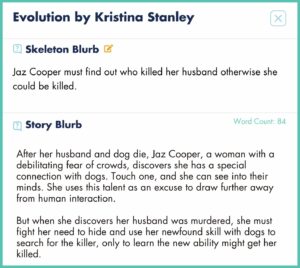
Writing a great story is like cooking an incredible meal.
There are many ingredients that all work together to create a delicious feast for your reader. You might have the greatest plot in the world, but if your characters are flat or inconsistent, your reader won’t care about them.
You might have the most engaging characters in the world, but if the world they inhabit is vague and bland, then they will be less able to envision it in their heads.
Kristina Stanley, Founder of Fictionary Software, spent years analysing and dissecting the world’s most popular stories. She put together a list of the most common ingredients that kept readers turning pages.
Take a free trial of Fictionary today and take your story to the next level.
Ok, let’s get started!
What Are Story Elements?
Simply put, a Story Element is one ingredient of many that needs to be considered in the overall recipe of your story. There are 38 Fictionary Story Elements altogether, and we group them into three main supergroups: Character Elements, Plot Elements, and Setting Elements.
Each Story Element helps you focus on the parts of your story that could better engage your reader and help you make creative choices. The choices a writer makes about each scene, the story elements, and the placement of the scenes all contribute to the story’s uniqueness.
Story Element Definition
A story element is a defined part of a story, and they create the backbone of every novel.
Each novel must contain the story elements in order to be complete.
The 3 Elements of a Story Groups
Although sometimes seen as separate, character, plot, and setting are linked.
Depending on the genre you’re writing in, one supergroup may take precedence over another. But every story—regardless of genre—requires all three. If you’ve written a high-octane action thriller, plot may be more prevalent. If you’re writing romance, character development might take top spot. And, if you’re writing fantasy or science fiction, setting will play a pivotal role.
Character Elements encompass anything to do with your cast of characters and their development, with particular emphasis on your protagonist. These include things like Point of View Character, Point of View Goal, and What If Goal Fails, which we’ll talk about in a moment.
Plot Elements comprise anything to do with your story, and its progression. These are things like your Story Arc, Conflict and Tension, and Entry and Exit Hooks.
Setting Elements consist of anything to do with world-building. These include things like weather, the Emotional Impact of setting, and the five senses. NOTE: Even if you’re not writing fantasy or sci-fi, world-building is still pivotal. We’ll talk about that later.
If you spend the time evaluating every Story Element in each scene, you will end up with an incredibly insightful map of your story. This will give you the 30,000 ft view that will help you see all of the ingredients and how they are working together to create your literary feats.

Character Story Elements

Creating believable characters can be tricky. Get it wrong, and they seem like cardboard cut out caricatures. But get it right, and readers will remember your characters forever.
Let’s start with three key story elements that are essential to consider if you want to write realistic characters: Point of View Character, Character Goal, and Character Stakes.
Note: If you want to go really deep, there are a lot more Character Elements in Fictionary StoryTeller software. Take a free trial now to see what we mean.
1. Point of View Character
For this Story Element, ask yourself: Do you have a strong and identifiable POV Character in every scene?
The Point of View (POV) character is the character telling the story in that scene. They’re the person through which your reader experiences the story. Your readers need someone to root for. If you don’t have a clear POV Character, readers will feel unanchored, like they can’t fully sink into the scene.
You can tell a single point of view story, or a story with multiple points of view.
If you’re writing a single point of view story, then one character tells the entire story. An example of this is Bridget Jones’s Diary by Helen Fielding. NOTE: Difficulty level—Easiest, but still not easy.
If you’re telling a multiple point of view story, then multiple characters tell the story. You can have a dual point of view which bounces back and forth between two characters. This is how JP Delaney wrote The Girl Before. NOTE: Difficulty level—Medium.
You can also have a large number of characters holding the POV in different scenes and chapters. This is how George R.R, Martin writes Game of Thrones. NOTE: Difficulty level—Expert.
Action: For every scene, make a note of your POV Character (or use the Fictionary software’s helpful drop-downs). If you can not clearly say, in every scene, who your POV character is, then your reader won’t know either. Help them direct their emotional energy toward the right person using this story element.
Top Tip: Beware Head Hopping
Head-hopping is when you switch POV multiple times in the same scene. Say, for example, you’re writing a scene from Jane’s POV, then—in the same scene—you write Alisha’s thoughts on the page. Jane can’t know Alisha’s thoughts if you’re writing in deep POV, and head-hopping like this throws readers out of the story.
2. POV Character Goal
For this Story Element, ask yourself: Does the POV Character in every scene have a clear goal?
Okay, now that you have a solid POV Character readers can root for, you need to make sure your POV Character wants something in every scene. This is their goal, and that’s what this story element focuses on.
If you’re writing a heist thriller, one scene goal might be to plan the heist. Another scene goal might be to gather equipment needed for the heist. And a third scene goal might be to carry out the heist. If you’re writing romance, and have a singleton POV Character, one goal might be to get through a friend’s wedding. Another might be to confess their feelings to their love interest.
Having a single point of view goal in each scene is vital for several reasons. If you have:
- No POV Goals: Your scenes will lack purpose, because your POV Character won’t be doing anything.
- Too Many POV Goals: Your scenes will feel unfocussed, and readers might struggle to work out what your POV Character wants.
- Unclear POV Goals: Similarly, if your Point of View Character’s goal is unclear, readers will struggle to root for them.
Action: For every scene, make a note of your POV Character’s Goal (or use the Fictionary software’s helpful drop-downs). If you can not clearly say, in every scene, what the goal is, then your reader won’t be as invested as you want them to be.
3. What if Goal Fails
For this Story Element, ask yourself: Will your reader understand the major negative consequence if my POV Character fails to achieve their goal in this scene?
Once you have an identifiable POV Character and solid POV Goal, you can think about what would happen if the POV Character fails to achieve their goal.
These are the stakes: what will be lost if they fail?
If there are no stakes—i.e., if nothing bad can happen as a result of the POV Character failing to achieve their goal—readers won’t care if they fail. Stakes create tension (which we’ll talk about when we discuss the plot supergroup), and tension drives the story forward.
Action: For every scene, make a note of your POV Character’s Goal (or use the Fictionary software’s helpful drop-downs). If you can not clearly say, in every scene, what the goal is, then your reader won’t be as invested as you want them to be.
Those 3 Character Elements Lead to Your Scene’s Skeleton Blurb
POV Character, POV Goal, and What If Goal Fails work in tandem to help you figure out whether you’ve got the makings of a good scene.
Use them to create a skeleton blurb for each scene (Yep! Every single scene should have this), following this structure:
- POV Character (Name): _____________
- Must (POV Goal): _____________
- Otherwise (What If Goal Fails/Stakes): _____________
Once you have these three elements in place, you’ll know you’ve got the framework for a good scene.

Plot Story Elements
Writing a great plot is no mean feat, but with the Fictionary Software, the task is so much simpler. Here are three Plot Elements guaranteed to keep your readers turning pages.
1. Your Story Arc
For this Story Element, ask yourself: Have you included the five Fictionary Story Arc Scenes in your novel, and do they occur in roughly the right place?
When Kristina Stanley developed the Fictionary Software, she wanted to simplify the storytelling process. Part of that was moving away from the piles of spreadsheets she used to track the progression of her story, and the story elements.
The Fictionary Story Arc is one of the key ways she achieved that.

Kristina analyzed all the popular story structure templates from Save the Cat Writes A Novel to The Hero’s Journey. She discovered they all share five plot points in common.
- Inciting Incident: An event that disrupts your protagonist’s everyday world and introduces the story conflict. This takes place prior to the 15% mark of your novel.
- Plot Point 1: The moment your protagonist decides to engage in the story conflict (i.e., has a story goal). This takes place between the 20 and 30% mark of your novel.
- Middle: An event that shifts your protagonist from a reactive to proactive state. This takes place between the 45 and 55% mark of your novel.
- Plot Point 2: An event that brings about your protagonist’s lowest moment. The key is they doubt their ability to solve the story conflict. This takes place between the 70 and 80% mark of your novel.
- Climax: The protagonist either achieves the story goal or doesn’t. They win or lose. They get together with their love interest or they don’t. This takes place between the 85 and 95% mark of your novel.
The reason all the plot points have a range for pacing (e.g., Plot Point 1 can be anywhere between 20 and 30%) is because this is a form, not a formula. Some stories require an earlier inciting incident, and others require a later climax.
By following the Fictionary Story Arc, you’ll feel confident you’re telling a story that’s well-paced and will attract readers.
Action: When reviewing your novel in the Fictionary Software, use the Story Arc insight to see how well your story arc measures up to the Fictionary Story Arc.
Top Tip: Revise Your Story Arc
The blue line is the Fictionary Story Arc, which shows you where your Story Arc Scenes should occur in your novel. The yellow line is your actual story arc. As you revise your novel, you can bring your story arc closer and closer to the recommended story arc.
Take a free trial of Fictionary today and take your story to the next level.
2. Conflict and Tension
For this Story Element, ask yourself: Have I included enough tension and conflict in my scenes?
Tension and conflict are the lifeblood of telling stories readers love.
Tension is the threat of something bad happening. Say your protagonist is walking home late at night. They hear footsteps behind them and convince themselves they’re being followed. They also believe the person following them will hurt them. That’s tension, because something bad could happen in this situation.
But, what about conflict, you cry.
Conflict follows tension, because the bad thing actually happens. Imagine the person following your protagonist attacks them, and they force your protagonist to defend themselves. That’s conflict because the fight is happening.
Hang on. Are you saying that tension and conflict can only centre around a physical fight?
Certainly not.
Let’s look at a quieter example.
Say you have a romantic couple in a scene. One party is answering the other’s questions with subtext loaded comments. That’s tension, because the use of subtext in conversation usually means an argument is right around the corner. If the person being hit with all that subtext bites back and this results in an argument, that’s conflict.

NOTE: You don’t have to include conflict in every scene, but we do recommend you include tension in every scene. Tension keeps things interesting for the reader and drives the story forward.
Action: Under the Plot tab on the Evaluate Page in the Fictionary software, write Strong next to scenes where the tension and conflict is great. Write Needs Improvement or None next to scenes that need work in this area. Once you’ve done this, you can use the Story Map to keep track of which scenes need revisiting.
3. Entry and Exit Hooks
For this Story Element, ask yourself: Have I opened and closed every scene in a way that encourages people to read on?
I know what you’re thinking. You want to write that kind of story. The kind of story that keeps readers up at night, long after they should have gone to sleep. You want them to turn up to work the next day feeling tired because they needed to finish your book.
Entry and exit hooks keep readers reading. You want to write them into the start and end of each scene. Their primary purpose is to make the reader ask questions they can only answer by reading on.
For entry hooks, consider:
- Starting in medias res (opening in the middle of the action)
- Foreshadowing trouble
- Using a strong line of dialogue
- Raising a question
- Not wasting words on extraneous description
For exit hooks, consider:
- Dramatic cliffhangers
- Revelations
- Setbacks for the protagonist or antagonist
- Secrets revealed
- Questions left hanging
- Unexpected plot twists
If you include compelling entry and exit hooks at the beginning and end of each scene, your readers will feverishly flip pages until they finish your books.
Action: Review the opening and closing lines of every scene. If your entry and exit hooks are strong, put a check mark next to these elements under the plot tab. If they aren’t hooking you and need work, make a note of that so you can come back and make them more gripping when you revise.
We’ve got the plot story elements sewn up. Let’s look at setting story elements.
Elements of Setting

Your setting is your story’s world. It’s the locations you choose, the important objects you include, and the sensory information you write. Setting is an afterthought for some writers, but we believe it’s just as important as Character and Plot.
Let’s look at three Settings Elements that you should consider if you want to use your setting to extend the emotional impact of your story.
1. Weather
For this Story Element, ask yourself: Am I using the Weather to create tension, strengthen the atmosphere, or place obstacles in front of my characters?
Weather is often underutilized in fiction, but it can lend itself to tension and character development. You can also use it to create obstacles for your protagonist and point of view characters.
For example, there’s a scene in Agatha Raisin and the Vicious Vet where Agatha’s driving on an icy road with the goal to get home. The road becomes too treacherous, and she can’t get home.
The road acts as an obstacle in this scenario, which prevents Agatha from achieving her goal.
Character development is also a great place to include weather.
Imagine a sunny day, which two different characters are experiencing. One character has a happy disposition, and the other is sullen. The happy character may revel in the sun, its brightness, and its warmth. The sullen character may be irritated by the heat and the way the sun is too hot.
Action: Pay attention to the weather. You don’t need to use weather in every scene (in fact, you definitely shouldn’t) but in every scene you should consider whether you could use it to add more atmosphere or impact. Use the Weather story element in Fictionary Software (under the Setting tab) to note of where you might need to make improvements when it’s time to revise.
2. Emotional Impact
For this Story Element, ask yourself: Are my scenes set in locations with a high emotional impact for the POV Character?
Setting isn’t just backdrop. It’s a chance to make your POV Character—and your readers—feel something.
Imagine a character who’s awaiting a call from their doctor with the results of a fertility test. You could set that scene anywhere. In their home. At their workplace. Or on a secluded walk through a forest. But do those locations carry the most emotional impact?
What if your protagonist received the call while she was walking back to work and happen to be passing a playground filled with kids laughing. Regardless of the fertility test’s outcome, receiving the news here is going to add an extra layer of emotional depth to the scene.
When choosing locations for your scenes, ask yourself, “Does this setting carry the most emotional impact, or is there somewhere else that will?”
Action: Review all your locations under the Setting tab on the Evaluate page of the Fictionary Software and ask yourself whether they heighten emotion in that scene. If not, write Needs Improvement in the Emotional Impact story element, so you can keep track of where you need to make revisions.
3. The Five Senses
For this Story Element, ask yourself: Have you included enough sensory information so the reader feels fully immersed in each scene?
In fiction, the five senses are the same five senses we canny humans use to navigate the world around us every day:
- Sight: Which can be used to describe new settings and people characters meet
- Sound: Which can be used to create a sense of atmosphere
- Smell: Which can be used to trigger flashbacks
- Taste: Which can be used in creative ways (e.g., using taste to describe an emotion)
- Touch: Which can be used to describe temperature and emotional feelings
As authors, we’re competing for our reader’s attention.
We’re not just up against other authors and their books. We’re competing with other media and streaming services like Netflix and Amazon Prime. These visual mediums are rich sensory experiences for the reader, using stunning visuals and backing tracks to immerse the reader in the story they’re telling.
We have to create that same experience in readers’ imaginations, and the five senses are the best way to do that.

Action: Use the Sight, Sound, Smell, Taste, and Touch Story Elements (under the Setting tab on the Evaluate page in the Fictionary Software) to keep track of places where your sensory information is top notch. Also, use these story elements to note where there aren’t enough senses in each scene. Doing this means you can keep track of where sensory information is lacking using the Story Map.
Top Tip: 3 Senses on Average
We recommend you use three senses (on average) per scene to really bring settings to life. We often rely on sight sense too much, but it’s important not to neglect the other four senses.
Conclusion: What is a Story Element?

There you have it, folks.
We’ve looked at nine ways that the Fictionary Story Elements can help you add more power and emotional impact to your manuscript. This is really just the tip of the iceberg. We recommend taking a free trial of [Fictionary StoryTeller software] to go even further.
But, let’s just look again at the top points:
For the Character supergroup, think about:
- Who your point of view character is
- What their goal is in each scene
- How you can include relevant stakes
For the Plot supergroup, think about:
- How you can use the Fictionary Story Arc to write a more cohesive, well-paced story
- What you can do to ramp up the conflict and tension
- How you can make your entry and exit hooks super engaging
For the Setting Supergroup, think about:
- How you’re using the weather to create obstacles
- Which locations are going to have the most emotional impact
- How you can use the five senses to create an immersive experience for readers
We’ve only been able to cover a few of the 38 Fictionary Story Elements here. Want to know more about the other elements, and how they can help you tell stories readers love? Take a free 7 day trial of the Fictionary Software.
Take a free trial of Fictionary today and take your story to the next level.


